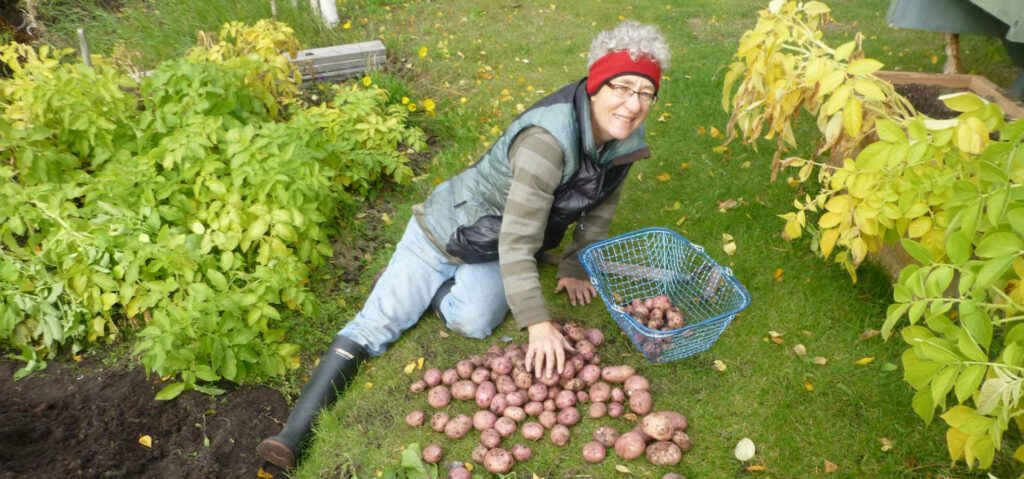Here’s another sneak peek from the upcoming spring edition of EDGEYK magazine:
We are gearing up for spring. Gumboots and garden implements are scrubbed, and this year, faintly smelling of swimming pool. Bleach is now among the precautionary steps we’re taking for garden season, after narrowly avoiding spudmageddon with last year’s potato crop.
Our lucky escape, and perhaps that of the whole NWT, began with some chance coincidences and a photo of the contents of our compost bin.
Maybe it was a bit weird to send a picture of rotting potatoes to someone across the Atlantic. But that someone was John Kerrane, my friend and potato guru in the UK. John, who studied potato blight for his PhD. John, who grows 11 different varieties of the tuber every year and whose autumn potato-tastings are legendary. I ask John’s advice on all things spud and had sent him a proud photo with just some of our crop in September. It was early November when I discovered, thanks partly to a sweetish, sickly smell, a few oozy, decaying potatoes amongst the four boxes we had carefully stored.
John emailed back: “It looks like Bacterial Ring Rot… I am not too familiar with this disease, as we don’t have it [in Britain], and the potato industry is desperate to keep it out. This is a very serious disease of potatoes, and in this country, and I think in British Columbia, it is a notifiable disease.”
It is very important that the entire community acts at once, as this can wipe out all of the potato crops in Northwest Territories.
Yikes! I sent the picture to Professor Steve Brown at the University of Alaska. In October, I had attended a workshop he did in Yellowknife on gardening North of 60. It just happens that he co-wrote a paper about BRR in 2012, and his response was also immediate, and even more apocalyptic than John’s: “This is an extremely serious disease. It is very important that the entire community acts at once as this can wipe out all of the potato crops in Northwest Territories.”
Steve went on to give advice about how to guard against BRR, which was discovered in Germany during the late 1800s and spread to the United States in the 1930s. According to a website for the Department of Agriculture and Fisheries in P.E.I., Canada’s most fabled potato-growing province, the ring rot caused serious crop losses until the early seventies, when intensive steps were taken to control it. There is zero tolerance for the disease, which has no cure. It can lurk without showing symptoms, in either the tubers or the plants. This is what to watch out for:
Tubers
These may look fine on the outside, while inside there is a faint brown ring just inside the skin. At the other end of the scale, the skin is cracked and inside is a disintegrating mush of cheesy ooze.
(As far as eating goes, some are too obviously revolting to contemplate, but, in retrospect, we certainly ate some in the early stages with absolutely no ill effect.)

A compost bin full of potatoes afflicted with Bacterial Ring Rot | Photo courtesy Ruth Bowen
Plants
Especially in cooler climates there may well be no symptoms, but those to watch out for include:
-
wilting on lower leaves
Article continues below advertisement -
leaves slightly rolled at margins
-
yellowing of leaf between veins
-
lighter green leaves
I wrote to all the local gardening groups with my compost bin photo, and Steve’s advice. It was posted on various websites and CBC North picked up the story. People I barely knew stopped me in the street and asked about my smelly potatoes. We had planted three different varieties from three different stores, and couldn’t remember which came from where, but the affected potatoes were all Organic Goldrush. One other person admitted to being similarly afflicted: her potatoes (variety unknown) were ones from the grocery store, sold for eating but which had subsequently sprouted.
As the days lengthen and we begin to dream of planning our gardens, now is the time to be on guard against BRR. As there is no cure and even apparently healthy-looking potatoes and seedlings could be infected, prevention is essential.
Here is Professor Steve Brown’s advice:
DOs
-
DO plant certified disease-free seed potatoes.
It is crucial certified disease-free seed potatoes be used each year.
-
DO wash and disinfect anything that may have come into contact with BRR.
Any tools used around those infected potatoes should be washed in very hot, soapy water and then disinfected with a 10 percent bleach/water solution (don’t be tempted to use 100 percent bleach, it is less effective). Everything that has come in contact (knives, cutting boards, shoes, etc.) has got to be cleaned and disinfected. Bacterial Ring Rot’s survival strategy is in the slime it produces. When it dries on the surface of a tool, it can survive for up to five years and be infecting everything which comes in contact.
-
DO be vigilant.
DON’Ts
-
DON’T cut seed potatoes.
t’s almost certain you got BRR by cutting seed potatoes. It is speculated that there was no BRR in North America until the potato industry starting cutting seed potatoes in the 1930s. In my own garden I do not cut seed potatoes… it results in a faster growing, healthier plant. [If you must do it] knives should be disinfected in 10 percent bleach/water in between every cut… let them heal for a week before planting.
-
DON’T grow potatoes in an infected location for at least a year.
-
DON’T compost infected potatoes.
Burning is good idea, but they can go in the landfill too.
-
DON’T plant potatoes left over from last year or those sold/grown for eating.
If you do find or suspect BRR:
On a commercial level, strict regulations in most of Canada require destruction of the crop. Steve Brown appreciates that for small gardeners this may not be realistic, and advises as the minimum the following:
-
Tell your fellow gardeners (especially important if you are in a community plot, sharing tools).
-
Be super-rigorous about cleaning all garden tools, and boots/shoes. “The important thing is to wash any garden tool after you’ve used it whether there is any disease present or not. Most folks would never think of using a plate or spoon over and over without washing it, the same should be true of any garden tool.”
-
Destroy infected tubers and all plant material (leaves etc.) NOT by composting (see above).
-
Don’t give away tubers from your crop: store them for your own consumption only, keep a close watch for infected potatoes and clean/disinfect or destroy storage containers and areas.
As well as bleaching our gumboots and all our gardening implements, we have a new planter, awaiting the certified seed potatoes that will be tenderly placed, uncut, in fresh soil. Fingers are firmly crossed that the pictures I send John in the fall will be of spuds that are healthy through and through.







